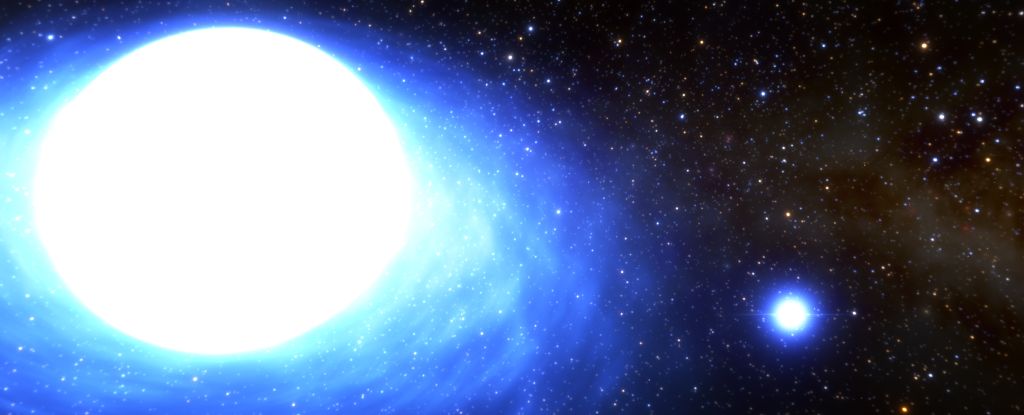For the first time, astronomers have unequivocally identified a binary star system destined to someday end up as a kilonova — the explosive result of a neutron star Collision.
And ironically, the key ingredient to that eventual fate is a pair of failed, hissing supernovae. This phenomenon is considered so rare that there are only an estimated 10 such binary star systems in the entire Milky Way. A closer look at this system should help scientists understand how these crazy events unfold.
“For quite some time, astronomers have speculated about the exact conditions that could ultimately lead to a kilonova,” says the astronomer André-Nicolas Chené by NOIRLab.
“These new results show that, in at least some cases, two sibling neutron stars can merge if one of them formed without a classic supernova explosion.”
Neutron star collisions are rare, but they play an important role in enriching the universe with heavy elements such as gold, platinum and uranium. These elements cannot be generated within stellar cores; The energy required for stellar nucleosynthesis of elements heavier than iron is greater than the energy this nucleosynthesis produces, resulting in a messy ending for the star.
Instead, these elements are formed in energetic events such as kilonovae: We have evidence of this from GW170817, the history-making neutron star collision observed from telescopes around the world. But these events are rare and therefore quite mysterious. We have seen few neutron star mergers and have never before found a system destined to become one.
Enter a binary system called CPD-29 2176 composed of a neutron star and a massive blue star called a be star, about 11,400 light-years from Earth. Be stars have features in their light that indicate the presence of disk-shaped matter around them.
You often too appear in binary systems with neutron starswhich emits X-rays when the neutron star passes through the disk around the Be star.
When a bright X-ray flash was observed from the same part of the sky as the Be star in CPD-29 2176, astronomers Noel Richardson and Clarissa Pavao of Embry-Riddle Aeronautical University took a closer look and eventually identified a portion of the light not from the Be- star broadcast. That was the neutron star.
They were also able to calculate the orbit of the binary. And this is where it got interesting. Because this orbit was unusually circular, in contrast to the more elliptical orbits usually seen in such binary stars.
This was the compelling evidence that led researchers to conclude that the neutron star was born in an “dud” supernova — also known as an ultra-stripping supernova.
Normally, when a massive star goes supernova, it blasts off its outer matter in a spectacular explosion, while the remaining core collapses into a neutron star — an ultradense object about 2.4 times the mass of the Sun, encapsulated in just a sphere packed is 20 kilometers (12 miles) wide.
In an ultra-stripped supernova, there is not enough outer material left to explode into space. Instead, the core collapses with little fanfare. This appears to have been the case with CPD-29 2176.
“The star was so exhausted that the explosion didn’t even have enough energy to push the orbit into the more typical elliptical shape seen in similar binary stars.” Richardson says.
Where has all the material gone? As the neutron star reached the end of its life, it became bloated, bringing its outer envelope within gravitational reach of the Be star, which slurped it directly. When the star collapsed into a neutron star, it was already completely disassembled, depriving it of the material that would otherwise have produced supernova fireworks.
Eventually, the Be star will also end its life as a neutron star, resulting in a neutron star binary in decaying orbit that will one day cause a neutron star collision, with the two merging to create either a larger neutron star or one black hole.
“The current neutron star would have to form without ejecting its companion from the system. An ultra-stripped supernova is the best explanation for why these companion stars are in such a close orbit.” Richardson says.
“To someday create a kilonova, the other star would also need to explode as an ultra-stripped supernova, allowing the two neutron stars to eventually collide and merge.”
However, that day is still far away. The Be star has at least a million years left before its inevitable transformation. And the slow inspiration for the eventual merger could take millions more. But with the identification of CPD-29 2176, astronomers have a new piece of the puzzle and one that could help identify other such systems among the billions of stars in the Milky Way.
“This system shows that some neutron stars form with just a small supernova kick,” Richardson says.
“By understanding the growing population of systems like CPD-29 2176, we will gain insight into how quiescent some stellar deaths can be and whether these stars can die without traditional supernovae.”
The research was published in Nature.





